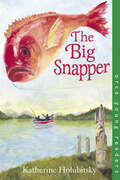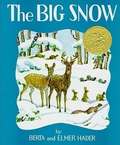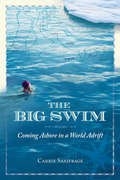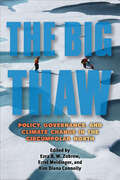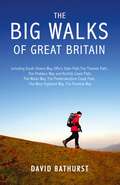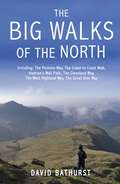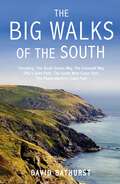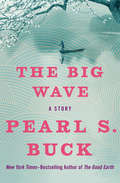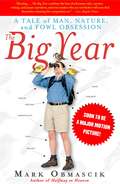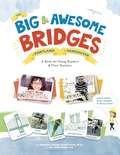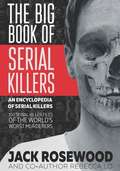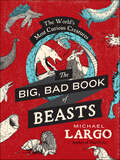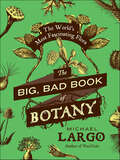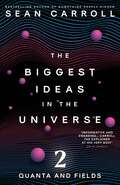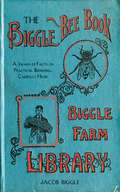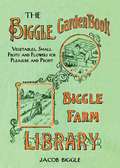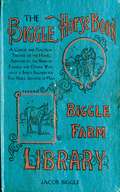- Table View
- List View
The Big Snapper (Orca Young Readers)
by Katherine HolubitskyEddie loves going fishing with Granddad and listening to his tall tales about the big snapper. Eddie believes if they catch such a fish, it might change his family's fortune. Ten-year-old Eddie lives with his mom and grandparents in a small cabin on the Queen Charlotte Islands. A year earlier, Eddie's dad took the ferry to the mainland and never returned... Mom decides to turn their cabin into a bed and breakfast. Some of the guests appreciate island life, but many do not. When Granddad falls ill and must go away for treatment, Eddie worries that he too may not come back. Already hurt and confused by his father's disappearance, upset by the attitudes of the tourists, and now missing his beloved grandfather, Eddie goes fishing alone in Granddad's skiff. Soon he is struggling with more than the need to stay afloat.
The Big Snow
by Berta Hader Elmer HaderFrom the book: WHEN the geese begin to fly south, the leaves flutter down from the trees and the cold winds begin to blow from the north, the animals of the woods and meadows, big and small, prepare for the long, cold winter ahead when the countryside is hidden under a deep blanket of snow. They gather food and look for warm, snug places in the ground, trees, caves or thickets, where they can find protection against the icy winds. It might have been hard for the birds and animals of the hillside to survive when the Big Snow came if their good friends, who lived in the little stone house, had not remembered to put food out for them. 1949 Caldecott Medal winner.
The Big Swim: Coming Ashore in a World Adrift
by Carrie SaxifrageHow the climate crisis changed one woman's life: &“Stunningly beautiful . . . I found myself laughing out loud on one page and brushing away tears on the next.&” —Ruth Ozeki, author of A Tale for the Time Being Climate change is alarming and complicated. Governments are acting too slowly or not at all, and not enough people feel informed or empowered enough to demand action. But ignoring a catastrophe of such magnitude is a certain path to disaster.The Big Swim puts forward the idea that personal growth arises from facing both inner tensions and threats to the biosphere. In a collection of stories that is frequently touching, surprisingly funny, and always thought-provoking, Carrie Saxifrage seeks out the places where science meets self-discovery, inviting us to join her as she: Learns the art of appreciation from an ancient jawboneHikes solo through the wilderness to find balance in a field of blueberriesSwims for four hours through cold, open water, seeking a fleeting state of grace Each of the stories in The Big Swim encourages possibilities for greater personal satisfaction with lower environmental impacts. While exploring significant topics, such as sustainable forestry, nature-centered philosophy, or First Nations&’ culture, the author discovers that the greatest adventure is learning to align how she lives with what she loves. By turning her own despair into action, she paves the way for us all to discover the many tools we have at hand to meet the biggest challenge humanity has ever faced.
The Big Thaw: Policy, Governance, and Climate Change in the Circumpolar North (SUNY series in Environmental Governance: Local-Regional-Global Interactions)
by Ezra B. W. Zubrow; Errol Meidinger; Kim Diana ConnollyClimate change, one of the drivers of global change, is controversial in political circles, but recognized in scientific ones as being of central importance today for the United States and the world. In The Big Thaw, the editors bring together experts, advocates, and academic professionals who address the serious issue of how climate change in the Circumpolar Arctic is affecting and will continue to affect environments, cultures, societies, and economies throughout the world. The contributors discuss a variety of topics, including anthropology, sociology, human geography, community economics, regional development and planning, and political science, as well as biogeophysical sciences such as ecology, human-environmental interactions, and climatology.This book is freely available in an open access edition thanks to Knowledge Unlatched—an initiative that provides libraries and institutions with a centralized platform to support OA collections and from leading publishing houses and OA initiatives. Learn more at the Knowledge Unlatched website at: https://www.knowledgeunlatched.org/, and access the book online at the SUNY Open Access Repository at http://hdl.handle.net/20.500.12648/7130.
The Big Thirst: The Secret Life and Turbulent Future of Water
by Charles FishmanPraised as &“an entertaining and torrential flow of a book&” by Nature magazine, The Big Thirst is a startling examination of the passing of the golden age of water and the shocking facts about how water scarcity will soon be a major factor in our lives.The water coming out of your kitchen tap is four billion years old and might well have been sipped by a Tyrannosaurus rex. Rather than only three states of water—liquid, ice, and vapor—there is a fourth, &“molecular water,&” fused into rock 400 miles deep in the Earth, and that&’s where most of the planet&’s water is found. Unlike most precious resources, water cannot be used up; it can always be made clean enough again to drink—indeed, water can be made so clean that it&’s toxic. Water is the most vital substance in our lives but also more amazing and mysterious than we appreciate. As Charles Fishman brings vibrantly to life in this surprising and mind-changing narrative, water runs our world in a host of awe-inspiring ways, yet we take it completely for granted. But the era of easy water is over. Bringing readers on a lively and fascinating journey—from the wet moons of Saturn to the water-obsessed hotels of Las Vegas, where dolphins swim in the desert, and from a rice farm in the parched Australian outback to a high-tech IBM plant that makes an exotic breed of pure water found nowhere in nature—Fishman vividly shows that we&’ve already left behind a century-long golden age when water was thoughtlessly abundant, free, and safe and entered a new era of high-stakes water. In 2008, Atlanta came within ninety days of running entirely out of clean water. California is in a desperate battle to hold off a water catastrophe. And in the last five years Australia nearly ran out of water—and had to scramble to reinvent the country&’s entire water system. But as dramatic as the challenges are, the deeper truth Fishman reveals is that there is no good reason for us to be overtaken by a global water crisis. We have more than enough water. We just don&’t think about it, or use it, smartly. The Big Thirst brilliantly explores our strange and complex relationship to water. We delight in watching waves roll in from the ocean; we take great comfort from sliding into a hot bath; and we will pay a thousand times the price of tap water to drink our preferred brand of the bottled version. We love water—but at the moment, we don&’t appreciate it or respect it. Just as we&’ve begun to reimagine our relationship to food, a change that is driving the growth of the organic and local food movements, we must also rethink how we approach and use water. The good news is that we can. As Fishman shows, a host of advances are under way, from the simplicity of harvesting rainwater to the brilliant innovations devised by companies such as IBM, GE, and Royal Caribbean that are making impressive breakthroughs in water productivity. Knowing what to do is not the problem. Ultimately, the hardest part is changing our water consciousness. As Charles Fishman writes, &“Many civilizations have been crippled or destroyed by an inability to understand water or manage it. We have a huge advantage over the generations of people who have come before us, because we can understand water and we can use it smartly.&” The Big Thirst will forever change the way we think about water, about our essential relationship to it, and about the creativity we can bring to ensuring that we&’ll always have plenty of it.
The Big Walks of Great Britain
by David BathurstAn indefatigable walker, David Bathurst has unlaced his boots to produce this invaluable companion to the fifteen best-loved long-distance footpaths of Great Britain. His appreciation of the British countryside and light-hearted style will appeal to novice and experienced walkers alike.
The Big Walks of Great Britain
by David BathurstAn indefatigable walker, David Bathurst has unlaced his boots to produce this invaluable companion to the fifteen best-loved long-distance footpaths of Great Britain. His appreciation of the British countryside and light-hearted style will appeal to novice and experienced walkers alike.
The Big Walks of the North
by David BathurstDavid Bathurst has unlaced his boots to produce this definitive companion to the ten best-loved long-distance footpaths in the north of Britain, with each split into manageable sections. Combining detailed descriptions with an appreciation of the beauty and history of the British countryside, this in an indispensable guide for all walkers.
The Big Walks of the North
by David BathurstDavid Bathurst has unlaced his boots to produce this definitive companion to the ten best-loved long-distance footpaths in the north of Britain, with each split into manageable sections. Combining detailed descriptions with an appreciation of the beauty and history of the British countryside, this in an indispensable guide for all walkers.
The Big Walks of the South
by David BathurstDavid Bathurst has unlaced his boots to produce this definitive companion to the ten best-loved long-distance footpaths in the south of Britain, with each split into manageable sections. Combining detailed descriptions with an appreciation of the beauty and history of the British countryside, this in an indispensable guide for all walkers.
The Big Walks of the South
by David BathurstDavid Bathurst has unlaced his boots to produce this definitive companion to the ten best-loved long-distance footpaths in the south of Britain, with each split into manageable sections. Combining detailed descriptions with an appreciation of the beauty and history of the British countryside, this in an indispensable guide for all walkers.
The Big Wave
by Pearl S. BuckThe classic tale of a Japanese boy orphaned by a tsunami from the author of The Good Earth, the first American woman to win the Nobel Prize in Literature. On a mountainside in Japan, two boys enjoy a humble life governed by age-old customs. Jiya belongs to a family of fishermen; his best friend, Kino, farms rice. But when a neighboring volcano erupts and a tidal wave swallows their village—including Jiya&’s family—life as they know it is changed forever. The orphaned Jiya must learn to come to terms with his grief. Now facing a profoundly different life than the one he&’d always taken for granted, he must decide on a new way forward. Written with graceful simplicity, The Big Wave won the Children&’s Book Award of the Child Study Association of America when it was first released. This ebook features an illustrated biography of Pearl S. Buck including rare images from the author&’s estate.
The Big Year: A Tale of Man, Nature, and Fowl Obsession
by Mark ObmascikEvery year on January 1, a quirky crowd of adventurers storms out across North America for a spectacularly competitive event called a Big Year -- a grand, grueling, expensive, and occasionally vicious, "extreme" 365-day marathon of birdwatching. For three men in particular, 1998 would be a whirlwind, a winner-takes-nothing battle for a new North American birding record. In frenetic pilgrimages for once-in-a-lifetime rarities that can make or break their lead, the birders race each other from Del Rio, Texas, in search of the rufous-capped warbler, to Gibsons, British Columbia, on a quest for Xantus's hummingbird, to Cape May, New Jersey, seeking the offshore great skua. Bouncing from coast to coast on their potholed road to glory, they brave broiling deserts, roiling oceans, bug-infested swamps, a charge by a disgruntled mountain lion, and some of the lumpiest motel mattresses known to man. The unprecedented year of beat-the-clock adventures ultimately leads one man to a new record -- one so gigantic that it is unlikely ever to be bested...finding and identifying an extraordinary 745 different species by official year-end count. Prize-winning journalist Mark Obmascik creates a rollicking, dazzling narrative of the 275,000-mile odyssey of these three obsessives as they fight to the finish to claim the title in the greatest -- or maybe the worst -- birding contest of all time. With an engaging, unflappably wry humor, Obmascik memorializes their wild and crazy exploits and, along the way, interweaves an entertaining smattering of science about birds and their own strange behavior with a brief history of other bird-men and -women; turns out even Audubon pushed himself beyond the brink when he was chasing and painting the birds of America. A captivating tour of human and avian nature, passion and paranoia, honor and deceit, fear and loathing, The Big Year shows the lengths to which people will go to pursue their dreams, to conquer and categorize -- no matter how low the stakes. This is a lark of a read for anyone with birds on the brain -- or not.
The Big and Awesome Bridges of Portland and Vancouver: A Book for Young Readers and Their Teachers
by Sharon Wood Wortman Ed WortmanThe big & awesome bridges of Portland & Vancouver is a book that gets young people excited about science and engineering and provides teachers a comprehensive resource for developing engaging elementary school units of study, all through an exploration of one of the most diverse and historic collections of big river bridges in the world.
The Big book of Serial Killers
by Jack RosewoodThese serial killers are not mythical beasts with horns and shaggy hair. They are people living among society, going about their day to day activities until nightfall. They are the Dennis Reader's, the fathers, husbands, church going members of the community.
The Big, Bad Book of Beasts: The World's Most Curious Creatures
by Michael LargoThe world's wildest collection of animal knowledge and lore!Lions, and tigers, and bears . . . and dinosaurs, dragons, and monsters. Oh my!For hundreds of years, the most popular books in the Western world next to the Bible were "bestiaries," fanciful encyclopedias collecting all of human knowledge and mythology about the animal kingdom. In these pages, eagles and elephants lived next to griffins and sea monsters. Now, in The Big, Bad Book of Beasts, award-winning author Michael Largo has updated the medieval bestsellers for the twenty-first century, illuminating little-known facts, astonishing secrets, and bizarre superstitions about the beasts that inhabit our world—and haunt our imaginations. You'll learn about the biggest bug ever, the smallest animal in the world, and the real creatures that inspired the fabled unicorns. You'll discover how birds learned to fly, why cats rub against your legs, and a thousand other facts that will make you look at nature in a wonderfully new way.Did you know?The fastest animal in the world is the peregrine falcon, which reaches speeds of over 200 miles per hours.Circus ringmaster P.T. Barnum fooled many when he displayed a "mermaid" carcass that was later proved to be monkey bones sewed together with the body of a fish.Discovered in a remote volcanic crater in New Guinea, the Bosavi wolly rat grows to the size of a cat.President Andrew Jackson bought an African gray parrot to keep his wife company. The bird outlived them both and was removed from Jackson's funeral for cussing in both English and Spanish.A to Z: From Aardvark to Zooplankton!For all ages!Includes 289 illustrations!
The Big, Bad Book of Botany: The World's Most Fascinating Flora
by Michael LargoDavid Attenborough meets Lemony Snicket in The Big Bad Book of Botany, Michael Largo’s entertaining and enlightening one-of-a-kind compendium of the world’s most amazing and bizarre plants, their history, and their lore.The Big, Bad Book of Botany introduces a world of wild, wonderful, and weird plants. Some are so rare, they were once more valuable than gold. Some found in ancient mythology hold magical abilities, including the power to turn a person to stone. Others have been used by assassins to kill kings, and sorcerers to revive the dead. Here, too, is vegetation with astonishing properties to cure and heal, many of which have long since been lost with the advent of modern medicine.Organized alphabetically, The Big, Bad Book of Botany combines the latest in biological information with bizarre facts about the plant kingdom’s oddest members, including a species that is more poisonous than a cobra and a prehistoric plant that actually “walked.” Largo takes you through the history of vegetables and fruits and their astonishing agricultural evolution. Throughout, he reveals astonishing facts, from where the world’s first tree grew to whether plants are telepathic.Featuring more than 150 photographs and illustrations, The Big, Bad Book of Botany is a fascinating, fun A-to-Z encyclopedia for all ages that will transform the way we look at the natural world.
The Biggest Ideas in the Universe 2: Quanta and Fields
by Sean CarrollTHE NEW YORK TIMES BESTSELLER &‘Neat, and extremely simple: only a deep thinker such as Sean Carroll could introduce the complexity of Einstein&’s general relativity in such a luminous and straightforward manner.&’ Carlo Rovelli, author of Seven Brief Lessons on Physics Immense, strange and infinite, the world of modern physics often feels impenetrable to the undiscerning eye – a jumble of muons, gluons and quarks, impossible to explain without several degrees and a research position at CERN. But it doesn&’t have to be this way! Allow world-renowned theoretical physicist and bestselling author Sean Carroll to guide you through the biggest ideas in the universe. Elegant and simple, Carroll unravels a web of theory to get to the heart of the truths they represent about the world around us. — In Quanta and Fields, the second in this landmark trilogy, Carroll delves into the baffling and beautiful world of quantum mechanics. From Schrödinger to Feynman, Carroll travels through the quantum revolution with the greatest minds of the twentieth century. Exploring how several decades of research overturned centuries of convention, Carroll provides a dazzling tour of the most exciting ideas in modern science.
The Biggest Puddle in the World
by Mark LeeSarah and Charlie hunt down the biggest puddle in the world with their grandfather in this fun introduction to the water cycle, perfect for young readers.When Sarah and her younger brother Charlie go to stay with their grandparents, it rains for days. At first, they have fun exploring inside the big, old house, but eventually they want to explore outside, too. “Where does the rain come from?” Sarah asks her grandfather, Big T. He promises to show her once it stops raining.When the storm passes, Sarah, Big T., Charlie and Keeper the dog go exploring. They jump in puddles, draw a puddle map and finally find the biggest puddle in the world!Mark Lee’s lively story is an introduction to the water cycle for young readers. Nathalie Dion’s soft illustrations show the fun, loving relationship between Big T., Sarah and Charlie.Correlates to the Common Core State Standards in English Language Arts:CCSS.ELA-LITERACY.RL.1.4Identify words and phrases in stories or poems that suggest feelings or appeal to the senses.
The Biggest Snowball Fight!
by Angela Shelf MedearisA snowball fight leads to a new dance and starts a new town tradition. picture descriptions added.
The Biggle Bee Book: A Swarm of Facts on Practical Beekeeping, Carefully Hived
by Jacob Biggle"As long as I can remember, even as a boy, there were bees kept on our farm," wrote Jacob Biggle in his preface to The Biggle Bee Book. "If for no other reason than to insure the proper fertilization of fruit and other blossoms, every farmer, fruit grower, or gardener should keep a few bees upon his grounds." Biggle's fifty colonies of bees, though requiring just a small part of his time, paid Biggle a larger return than any other animal on his farm. Not only did he take pleasure in caring for these wonderful insects and enjoying the honey they produced, he also recognized that their presence on his farm meant that his orchards and crops would flourish.If there are any so-called secrets to the art of beekeeping, Jacob Biggle does his best to expose them all in this delightful little volume. His hope was that readers could profit from his hard-earned wisdom that included:The benefits of keeping beesHow to care for bees through the winterThe marketing and selling of wax- and honey-based productsWhat bee-friendly plants to raise in the gardenHow to introduce a new queen to the hiveWritten not only for the professional beekeeper, but also for the backyard farmer, and anyone interested in rural life, self-sufficiency, and farming techniques of the past, this book is an essential addition to the home library.
The Biggle Garden Book: Vegetables, Small Fruits and Flowers for Pleasure and Profit (Gardening In America Ser.)
by Jacob BiggleWhen The Biggle Garden Book was first published in 1908, most people were in the habit of raising their own food and flowers. Jacob Biggle felt that a gardener's success had to do with willpower and passion rather than acreage. "The man, woman or youngster who really wants a garden, will somehow manage to have a good one regardless of soil conditions, bad weather, measles in the family, or whether the area of ground at hand is a square acre or a square rod," he wrote encouragingly at the start of the book.That passion for gardening continues today in fields, backyards, and urban community plots across the United States. According to a poll taken in 2009 by the National Gardening Association, more than forty-three million households in the United States grow some of their own food. Learn how to do things the "old-school" way as Jacob and Harriet Biggle guide you through the fundamentals of:Soil preparation, sowing, and plantingHotbeds and cold framesFertilization, cultivation, and irrigationFlower gardening with old-fashioned favoritesGarden pests and friendsWith a resurgence in organic farming, heirloom varieties, and self-reliant living, The Biggle Garden Book is more valuable than ever because of the time-tested advice it offers.
The Biggle Horse Book: A Concise and Practical Treatise on the Horse, Adapted to the Needs of Farmers and Others Who Have a Kindly Regard for This Noble Servitor of Man
by Jacob Biggle"People ought to try to make their horses happy," wrote Jacob Biggle's wife Harriet in The Biggle Horse Book in 1894. "A happy, cheerful horse will do more work and live longer, and thus be more profitable to its owner, than one whose temper is kept constantly ruffled, whose disposition is soured by ill-usage, and whose peace of mind is often disturbed by the crack of the whip, the hoarse voice of the driver, the strain of overwork, the discomfort of a hard bed, or the pangs of hunger and thirst." When it comes to the treatment of animals--especially the horse--the Biggles were ahead of their time.Folksy and informative, this manual offers timeless tips on the effective and humane treatment and training of horses and detailed descriptions of all the major breeds. Practical horsemen and veterinarians of the era contributed their wisdom and insight, and their maxims on owning, riding, and working with horses will provide endless hours of entertainment. Here are just a few:"Proper food and lots of sentiment will make with good blood a good horse.""If you must put frosty bits in some mouths, let it be your own. Suffering begets sympathy.""The three greatest enemies of the horse are idleness, fat, and a dumb blacksmith.""Don't try to fit a horse to the collar. It won't work. Fit the collar to the horse."Enhanced with beautiful engravings, illustrations, and snippets of poetry throughout, The Biggle Horse Book remains a loving and fitting tribute to "this noble servitor of man."
The Biggle Poultry Book: A Concise and Practical Treatise on the Management of Farm Poultry
by Jacob BiggleWhen Jacob Biggle first published his book on the management of poultry, there were more than 300 million chickens and 30 million other domesticated fowl in the United States. Today, the trend continues with thousands if not millions of chickens and other fowl being raised in suburban and urban backyards across America. Biggle's aim was to "help farmers and villagers conduct the poultry business with pleasure and profit." To that end, this handy little volume contains all the information the reader needs to know, such as:The various breeds of chickens, turkeys, guinea fowl, ducks, geese, and pigeonsThe most common diseases and enemies that threaten our feathered friendsRaising hens expressly for eggs rather than meatThe farmer's flock versus the village henneryThe art of hatching eggs and caring for chicksWritten for the practical farmer who raises poultry and eggs for market,The Biggle Poultry Book will also appeal to collectors of farm ephemera and anyone else who is nostalgic for a simpler way of doing things. Illustrated with sixteen color plates by Louis P. Graham, and hundreds of black-and-white photographs and illustrations throughout, The Biggle Poultry Book is as beautiful as it is useful and a treasure for the home library.
The Biggle Swine Book: Much Old and More New Hog Knowledge, Arranged in Alternate Streaks of Fat and Lean
by Jacob BiggleWhen Jacob Biggle first published The Biggle Swine Book in 1898, hog husbandry was undergoing major changes. New feeding methods had come into vogue, new breeds of hogs had been developed, and significant progress had been made in curbing swine-borne epidemics. Even the public perception of pigs as filthy creatures wallowing up to their knees in mud had brightened, and pigs were accorded a modicum of respect. But with the onset of railroad development across the United States, the backyard pig farmer started losing ground to slaughterhouses and large processing plants.The Biggle Swine Book captures this moment in American history when home animal husbandry was giving way to more industrialized meat production. Nevertheless, Jacob Biggle continued to offer guidance to the small-scale farmer on all manner of livestock issues, centered around the proper breeding, feeding, and care of pigs. His book includes valuable instructions on: What to do at farrowing timeConstructing the piggery and styKeeping on top of the manure pileButchering and curing meatsProtecting your animals from various pig ailmentsIllustrated with photographs, engravings, and line drawings throughout of all things pig-related, this book is a glimpse into a bygone era when sows and their litters had a place on every farm, and people knew exactly where their bacon came from.
